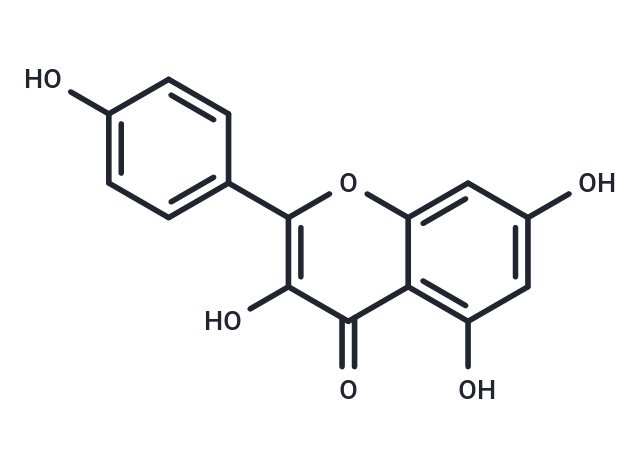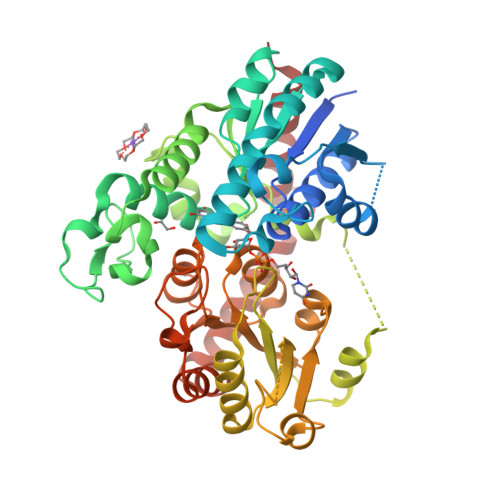 您的购物车当前为空
您的购物车当前为空
Kaempferol
一键复制产品信息别名 山柰酚, 山奈酚, Robigenin, Kempferol
Kaempferol (Robigenin) 属于天然类黄酮,是一种 ERRα 和 ERRγ 的反向激动剂。Kaempferol 具有抗肿瘤、抗炎、抗氧化、抗菌和抗病毒等多种活性。

Kaempferol
一键复制产品信息Kaempferol (Robigenin) 属于天然类黄酮,是一种 ERRα 和 ERRγ 的反向激动剂。Kaempferol 具有抗肿瘤、抗炎、抗氧化、抗菌和抗病毒等多种活性。
| 规格 | 价格 | 库存 | 数量 |
|---|---|---|---|
| 20 mg | ¥ 110 | 现货 | |
| 50 mg | ¥ 198 | 现货 | |
| 100 mg | ¥ 380 | 现货 | |
| 500 mg | ¥ 896 | 现货 | |
| 1 g | ¥ 1,290 | 现货 | |
| 1 mL x 10 mM (in DMSO) | ¥ 160 | 现货 |
产品介绍
| 产品描述 | Kaempferol (Robigenin) is a natural flavonoid and an inverse agonist of ERRα and ERRγ. Kaempferol has a wide range of antitumor, anti-inflammatory, antioxidant, antibacterial and antiviral activities. |
| 靶点活性 | HMGB1:28.9 μM (Kd), NO release:5.02 μM (RAW264.7 cells), Antiamoebic activity (against N. fowleri trophozoites):29.28 ± 0.63 μM |
| 体外活性 | 方法:人乳腺癌细胞 MDA-MB-231 用 Kaempferol (0.01-100 μM) 处理 72 h,使用 MST assay 检测细胞活力。 |
| 体内活性 | 方法:为研究对失血性休克小鼠的影响,将 Kaempferol (10 mg/kg) 腹腔注射给经历失血性休克的 C57/BL6 的小鼠。 |
| 激酶实验 | Right atria or sinus nodal cells are homogenized in lysis buffer consisting of (50 mM Tris-HCl pH 7.5, 100 mM KCl, 1 mM ethylenediamine tetraacetic acid, 1 mM ethylene glycol tetraacetic acid, 1 mM dithiothreitol, 0.1 mM phenylmethylsulfonyl fluoride, 0.5 mM Benzamidine, 20 mg/L Leupeptin, 20 mM sodium pyrophosphate, 50 mM NaF, and 50 mM sodium β-glycerophosphate), and total protein content is determined by the Bradford assay. Caspase-3 activity is determined by EnzChek Caspase-3 Assay Kit[3]. |
| 细胞实验 | Kaempferol is prepared in DMSO (100 mM) and stored (-20°C), and then diluted with appropriate medium[2]. Ovarian cancer cells are seeded in 96-well plates at 2000 cells/well and incubated overnight before treatment with 0-160 μM Kaempferol for 24 hours in triplicates. The medium is removed, and the plates are freeze-thawed to lyse cells. Each well is added with 200 μL 1× CyQUANT cell lysis buffer containing 5x SYBR Green I and incubated at room temperature (RT) for 5 minutes. The reaction (50 μL) is transferred to PCR strip tubes and the fluorescent signal is measured at 90°C with a real-time Chromo4 PCR instrument. To ensure that cell proliferation assays are performed within a linear range of cell numbers, a standard curve is generated by seeding different amount of OVCAR-3 cells (based on counting with a hemacytometer) in a 96-well plate, and measuring genomic DNA abundance after overnight incubation. Three independent experiments are performed and data is pooled for statistical analysis[2]. |
| 别名 | 山柰酚, 山奈酚, Robigenin, Kempferol |
| 分子量 | 286.24 |
| 分子式 | C15H10O6 |
| CAS No. | 520-18-3 |
| Smiles | O=C1C=2C(OC(=C1O)C3=CC=C(O)C=C3)=CC(O)=CC2O |
| 密度 | 1.688 g/cm3 |
| 颜色 | Yellow |
| 物理性状 | Solid |
| 存储 | Powder: -20°C for 3 years | In solvent: -80°C for 1 year | Shipping with blue ice/Shipping at ambient temperature. | ||||||||||||||||||||||||||||||||||||||||
| 溶解度信息 | H2O: < 1 mg/mL (insoluble or slightly soluble) Ethanol: 28.6 mg/mL (99.92 mM), Sonication is recommended. DMSO: 45 mg/mL (157.21 mM), Sonication is recommended. | ||||||||||||||||||||||||||||||||||||||||
| 体内实验配方 | 10% DMSO+40% PEG300+5% Tween 80+45% Saline: 2.87 mg/mL (10.03 mM), Solution. 请按顺序添加溶剂,在添加下一种溶剂之前,尽可能使溶液澄清。如有必要,可通过加热、超声、涡旋处理进行溶解。工作液建议现配现用。以上配方仅供参考,体内配方并不是绝对的,请根据不同情况进行调整。 | ||||||||||||||||||||||||||||||||||||||||
溶液配制表 | |||||||||||||||||||||||||||||||||||||||||
Ethanol/DMSO
DMSO
| |||||||||||||||||||||||||||||||||||||||||
TCMIP相关数据
| 中药材名称 | 中药材拉丁名 | 性 | 味 | 归经 |
|---|---|---|---|---|
| 大黄 | Rheum palmatum L., Rheum tanguticum Maxim. ex Bal£., Rheum officinale Bail | 寒 | 苦 | 脾, 胃, 大肠, 肝, 心包 |
| 中成药名称 | 处方组成 | 中成药类型 |
|---|---|---|
| 保利尔胶囊 | 广枣,丹参,肉豆蔻,栀子,川楝子,茜草,红花,麦冬,三七,土木香,木香,檀香,人工牛黄,牛心,降香,大黄,木通,黄芪,荜茇,人工麝香,诃子 | 祛瘀药 |
| 冰栀伤痛气雾剂 | 大黄,栀子,肿节风,地黄,降香,韭根,马钱子,冰片,桃仁,松节,干姜,花椒,樟脑,苏木,樟根,松笔头 | 清热药 |
| 博尔宁胶囊 | 黄芪,女贞子,光慈菇,重楼,龙葵,紫苏子,僵蚕,大黄,冰片,马齿苋,鸡内金 | 清热药 |
| 阿魏化痞膏 | 香附,厚朴,三棱,莪术,当归,生草乌,大蒜,使君子,白芷,穿山甲,木鳖子,蜣螂,胡黄连,大黄,蓖麻子,乳香,没药,芦荟,血竭,雄黄,肉桂,樟脑,阿魏 | 祛瘀药 |
| 安胃止痛片 | 海螵蛸,小茴香,珍珠母,肉桂,干姜,山萘,大黄,丁香,陈皮(制),花椒,薄荷脑,甘草 | 扶正药 |
| 参柏舒阴洗液 | 苦参,黄柏,丹参,大青叶,硼砂,大黄,黄芩,黄连,甘草,蛇床子,土茯苓 | 扶正药 |
| 八正片 | 翟麦,车前子(炒),大黄,滑石,川不通,栀子,灯心草,甘草 | 祛湿药 |
| 安胃止痛胶囊 | 海螵蛸,小茴香,珍珠母,肉桂,干姜,山萘,大黄,丁香,陈皮(制),花椒,薄荷脑,甘草 | 扶正药 |
| 八正胶囊 | 栀子,车前子(炒),瞿麦,匾蓄,滑石,大黄,川木通,灯心草,甘草 | 祛湿药 |
| 安胃止痛散 | 海螵蛸,小茴香,珍珠母,肉桂,干姜,山柰,大黄,丁香,陈皮(制),花椒,薄荷脑,甘草 | 扶正药 |
| 八正颗粒 | 瞿麦,车前子(炒),萹蓄,大黄,滑石,川木通,栀子,甘草,灯心草 | 祛湿药 |
| (山黎)峒丸 | 三七,血竭,阿魏,乳香(制),没药(制),藤黄(制),天竺黄,大黄,儿茶,冰片,雄黄,牛黄,麝香,山羊血 | 扶正药 |
| 八正颗粒(无糖型) | 瞿麦,车前子(炒),萹蓄,大黄,滑石,川木通,栀子,甘草,灯心草 | 清热药 |
| 冰连清咽喷雾剂 | 金银花,甘草,大黄,冰片,薄荷脑 | 清热药 |
| 参附强心丸 | 人参,附子(制),桑白皮,猪苓,葶苈子,大黄 | 扶正药 |
| 参柏洗液 | 苦参,黄柏,丹参,大青叶,硼砂,大黄,黄芩,黄连,甘草,蛇床子,土茯苓 | 清热药 |
| 鳖甲煎丸 | 鳖甲胶,阿胶,蜂房(炒),鼠妇虫,土鳖虫(炒),蜣螂,硝石(精制),柴胡,黄芩,半夏(制),党参,干姜,厚朴(姜制),桂枝,白芍(炒),射干,桃仁,牡丹皮,大黄,凌霄花,葶苈子,石韦,瞿麦 | 祛瘀药 |
| 冰黄软膏 | 大黄,硫黄,黄连,冰片,氯霉素 | 清热药 |
| 冰黄肤乐软膏 | 大黄,姜黄,硫黄,黄芩,甘草,冰片,薄荷脑 | 清热药 |
| 参归养血片 | 人参,黄芪,白术,五味子,当归,川芎,女贞子,牡蛎,枸杞子,何首乌,大黄,木香 | 扶正药 |
| 方剂名称 | 处方组成 | 剂型 | 处方来源 |
|---|---|---|---|
| 五香丸5 | 青木香,犀牛角,升麻,羚羊角,黄芩,栀子,沉香,丁香,熏陆香,麝香,鬼臼,大黄,芒硝 | 丸剂 | 《外台》卷十三引《延年方》。 |
| 五香连翘汤3 | 青木香,母丁香,沉香,麝香,乳香,升麻,桑寄生,独活,木通,牛舌,大黄,连翘 | 汤剂 | 《普济方》卷二八三。 |
| 五香丸3 | 沉香,青木香,丁香,朱砂,麝香,犀牛角,熏陆香,栀子,连翘,石膏,芒硝,升麻,大青,干蓝,瓜蒌,葛根,茵陈,黄芩,肉桂,川芎,茯苓,巴豆,大黄 | 丸剂 | 《外台》卷三十七。 |
| 五香丸6 | 青木香,麝香,沉香,苏合香,鸡舌香,犀牛角,吴蓝,黄连,栀子,当归,炙甘草,防风,黄芪,黄芩,芍药,红蓼,升麻,大黄,巴豆 | 丸剂 | 《医方类聚》卷二四八引《保童秘要》。 |
| 五香汤1 | 木香,熏陆香,海藻,麝香,沉香,枳实,升麻,射干,大黄,竹沥 | 汤剂 | 《幼幼新书》卷三十五引《婴孺方》。 |
| 五香丸7 | 木香,沉香,苏合香,麝香,犀牛角,大黄,鸡舌香,吴蓝,栀子,熟地黄,白芍,人参,茯苓 | 丸剂 | 《圣济总录》卷一八二。 |
| 五味汤2 | 五味子,黄芩,柴胡,芒硝,麦冬,石膏,黄连,甘草,当归,大黄 | 汤剂 | 《幼幼新书》卷十四引《婴孺方》。 |
| 五香连翘汤1 | 桑白皮,木香,连翘,沉香,黄芪,升麻,木通,麝香,独活,丁香,乳香,大黄,甘草 | 汤剂 | 《普济方》卷二八二。 |
| 五香连翘汤5 | 青木香,鸡舌香,桑寄生,沉香,木通,黄芪,大黄,麝香,乳香,藿香,升麻,连翘 | 汤剂 | 《医方类聚》卷一七四引《外科精要》。 |
| 五香连翘丸 | 木香,沉香,人参,鸡舌香,乳香,芍药,玄参,海藻,肉桂,大黄,芒硝,牛蒡子,桃仁,当归,连翘,麝香 | 丸剂 | 《圣济总录》卷一二八。 |
| 五香连翘汤2 | 木香,沉香,连翘,射干,升麻,黄芪,木通,甘草,丁香,乳香,大黄,麝,桑寄生,独活 | 汤剂 | 《集验背疽方》。 |
| 五味子丸17 | 五味子,天冬,白芍,防己,车前子,槟榔,牵牛子,大黄,芒硝 | 丸剂 | 《圣济总录》眷五十四。 |
| 五香连翘汤 | 木香,独活,射干,连翘,甘草,桑寄生,升麻,沉香,鸡舌香,乳香,大黄,麝香 | 汤剂 | 《圣济总录》卷一二八。 |
| 五味子汤 | 五味子,当归,麻黄,干姜,桂心,人参,紫菀,甘草,细辛,款冬花,大黄 | 汤剂 | 《千金》卷五。 |
| 五味子汤12 | 五味子,甘草,当归,大黄,芒硝,麦冬,黄芩,前胡,石膏,黄连 | 汤剂 | 《千金》卷五。 |
| 五和汤 | 当归,赤茯苓,炙甘草,大黄,枳壳 | 汤剂 | 《活幼心书》卷下。 |
| 五味败毒散 | 羌活,独活,前胡,柴胡,枳壳,桔梗,甘草,人参,茯苓,川芎,大黄,苍术 | 散剂 | 《赤水玄珠》卷十一。 |
| 五味大黄丸 | 大黄,火麻仁,芒硝,葛根,桑白皮 | 丸剂 | 《外台》卷二十七引《许仁则方》。 |
| 五香汤 | 麝香,木香,丁香,沉香,乳香,芍药,枳实,射干,连翘,黄芩,麻黄,升麻,甘草,大黄 | 汤剂 | 《伤寒总病论》卷四。 |
| 五香汤4 | 麝香,青木香,鸡舌香,藿香,熏陆香,当归,黄芩,升麻,芒硝,大黄 | 汤剂 | 《外台》卷二十三引《崔氏方》。 |
 化合物与蛋白结合的复合物
化合物与蛋白结合的复合物

Crystal structure of the 17beta-hydroxysteroid dehydrogenase from Cochliobolus lunatus in complex with NADPH and kaempferol
计算器
体内实验配液计算器
以上为“体内实验配液计算器”的使用方法举例,并不是具体某个化合物的推荐配制方式,请根据您的实验动物和给药方式选择适当的溶解方案。
剂量转换
对于不同动物的给药剂量换算,您也可以参考 更多




 很棒
很棒
 |
|